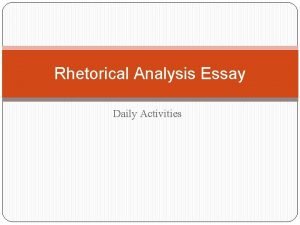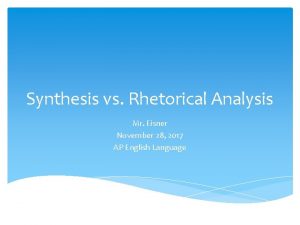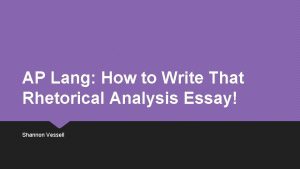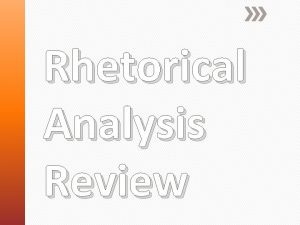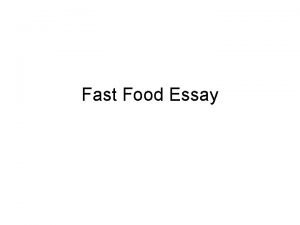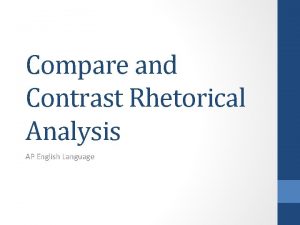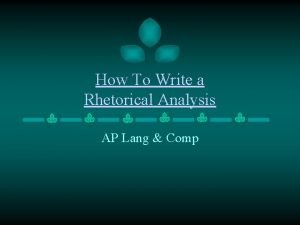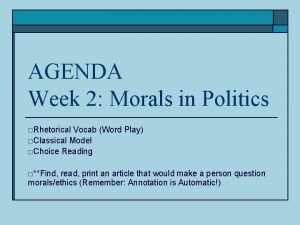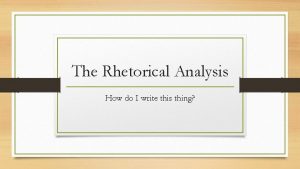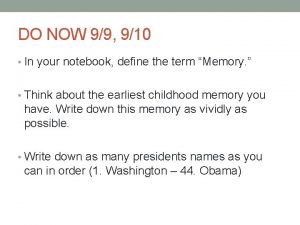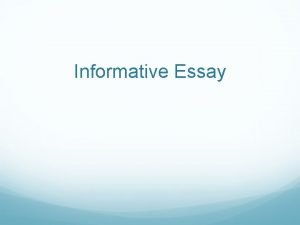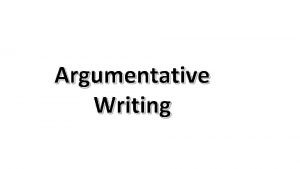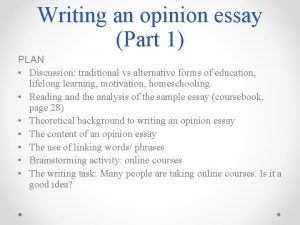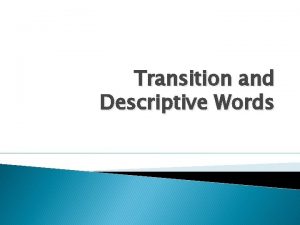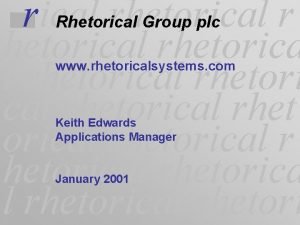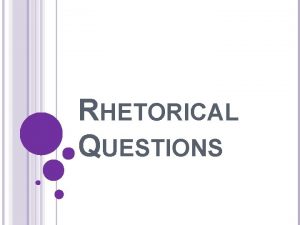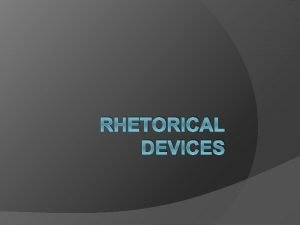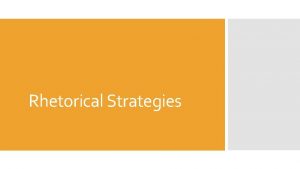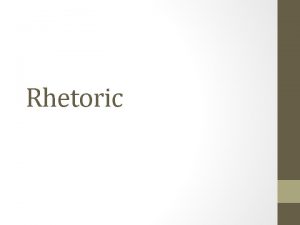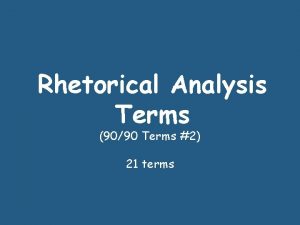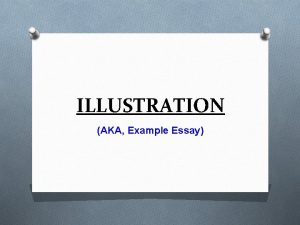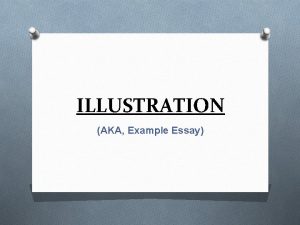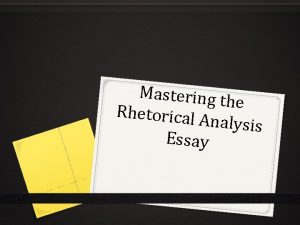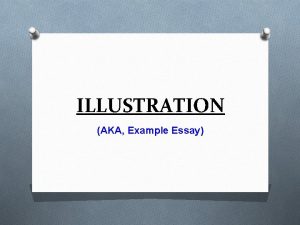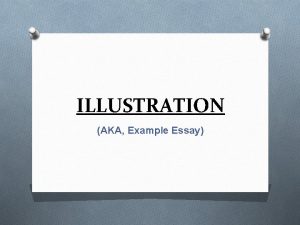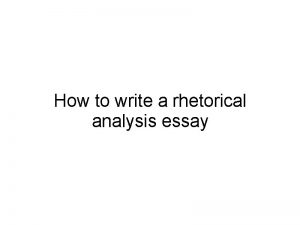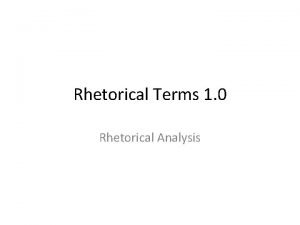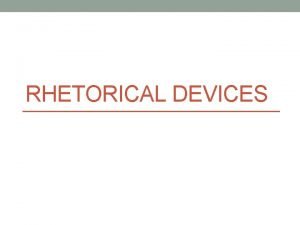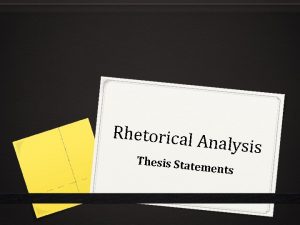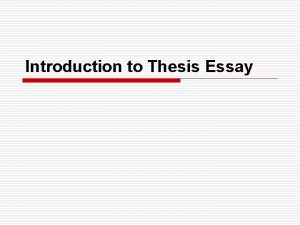Rhetorical Terms ESSAY WORDS 2 Thesis Thesis thesis






















- Slides: 22

Rhetorical Terms ESSAY WORDS #2

Thesis • Thesis – thesis statement is the sentence or group of sentences that directly expresses the author’s opinion, purpose, meaning, or position. • Example of an argument thesis: Although many believe that polite speech is necessary to maintaining a peaceful society, such hollow words are actually detrimental to society because they sterilize language to the point that words lose their true meaning.

Thesis Usage �How? Rhetorical Analysis: Includes the rhetorical strategies the author uses and how it affects the piece Argument: Includes the claim and grounds Synthesis: Includes the claim and grounds �Why? A good writer has a strong thesis in her writing. A thesis is the MOST IMPORTANT part of the essay Usually the last sentence of the first paragraph May be one or two sentences, but should be CLEAR and TIGHT

Rhetorical Question �A question asked by a writer or speaker but is not answered because its answer is obvious. It is asked merely for effect, for no answer is expected. �Why? It used for effect, emphasis, or provocation, or for drawing a conclusionary statement from the facts at hand. �Examples: “If practice makes perfect, and no one’s perfect, then why practice? ” “For if we lose the ability to perceive our faults, what is the good of living on? ” –Marcus Aurelius

Rhetorical Question Usage �How? Examples: “If practice makes perfect, and no one’s perfect, then why practice? ” “For if we lose the ability to perceive our faults, what is the good of living on? ” –Marcus Aurelius �Why? It used for effect, emphasis, or provocation, or for drawing a conclusionary statement from the facts at hand.

Anecdote �A short and amusing or interesting story about a real incident or person.

Anecdote Usage �How? Amusing anecdotes are often used in literature, family reunions, wedding receptions and other get-togethers. Teachers tell anecdotes to their students in classrooms about eminent people and celebrities. �Why? Used to support or demonstrate some point and make readers and listeners laugh or understand

Inference/infer �To draw a reasonable conclusion from the information/evidence presented �Ex. – If Joey is always wearing Dodger shirts, we can infer that his favorite team is the Dodgers.

Usage �How? Ex: From “The Big Bang Theory” �Sheldon: I took another look at the board, and I realized you were right. Raj: So you were wrong. Sheldon : I’m not saying that. Raj: That’s the only logical inference. Sheldon: I’m still not saying it. �Why? The author implies something so that he/she doesn’t have to “spell it out”—this leads to a deeper understand by the reader.

Analogy �A similarity or comparison between two different things or the relationship between them. �Ex. – “Life is like a box of chocolates. You never know what you’re going to get. ”

Analogy Usage �How? Link an unfamiliar or a new idea with common and familiar objects. Examples: Just as a sword is the weapon of a warrior, a pen is the weapon of a writer. How a doctor diagnoses diseases is like how a detective investigates crimes. �Why? It explains an idea or thing by comparing it to something that is familiar. Writers use it to catch the attention of their readers, or to increase readers’ interest by helping them relate what they read to their life.

Zeugma �A figure of speech in which a word (usually a verb or an adjective) applies to more than one noun, blending together grammatically and logically different ideas.

Zeugma Usage �How? Examples: “You held your breath And the door for me” -”Head Over Feet”, Alanis Morrissette “Gold teeth and a curse for this town They’re all in my mouth” -“New Slang”, The Shins �Why? It produces a unique artistic effect, making the literary works more interesting and effective as it serves to add emphasis to ideas.

Metonymy �A figure of speech in which the name of one object is substituted for that of another closely associated with it.

Metonymy Usage � HOW? Examples: “The Golden-Arches has its annual Monopoly contest going on. ” The Golden-Arches takes the place of Mc. Donald’s. “The crown” is used to represent power or authority , “the pen is mightier than the sword” “Let me give you a hand. ” The hand means help. � Why? It gives more profound meanings to otherwise common ideas and objects. By using metonymy, texts exhibit deeper or hidden meanings, thus drawing readers’ attention. � NOTE: In a metonymy, the word we use to describe another thing is closely linked to that particular thing, but is not a part of it. (Different than synecdoche)

Synecdoche– (sin-neck-da-key) � A figure of speech in which a part of something is used to represent the whole Example – “My seat’s been taken by some sunglasses/ Asking about a scar” - “We Are Young”, fun. This shows that a person is being referred to by one accessory that he is wearing rather than the person as a whole.

Synecdoche Usage � How? The soldiers were equipped with steel” vs. “The soldiers were equipped with swords, knives, daggers, arrows…” Which sounds cooler? “ � Why? Gives common ideas deeper meanings Draws readers’ attention through creativity Helps writer achieve brevity

Difference between Metonymy and Synecdoche � Synecdoche refers to a thing by the name of one of its parts. For example, calling a car “a wheel” is a synecdoche. A part of a car i. e. “a wheel” stands for the whole car. �In a metonymy, on the other hand, the word we use to describe another thing is closely linked to that particular thing, but is not a part of it. For example, “Crown” which means power or authority is a metonymy.

Onomatopoeia �Onomatopoeia – a figure of speech in which natural sounds are imitated in the sounds of words. Example – buzz, hiss, hum, crack

Onomatopoeia Usage �How? “The click-clack of the headmistress’s heels sent Maurice sinking down in his seat. ” �Why? Onomatopoeia helps the reader hear the sounds the words reflect, adding depth and dimension to a description. A simple, plain description does not have the same emphatic effect as can onomatopoeia.

Synesthesia • To present ideas, characters or places in such a manner that they appeal to more than one senses like hearing, seeing, smell etc. at a given time. • Example – The sight of red ants makes me itchy.

Synesthesia Usage � How? By blending different senses Example: The word “cool” In casual conversations, we can hear phrases like “cool dress” , “cool colors” or “you are looking cool” wherein the visual sensation is blended with the sense of touch. � Why? By blending different senses, the author amplifies the text, making it more interesting, complex, rich, vivid, and meaningful.
 Rhetorical analysis activities
Rhetorical analysis activities Rhetorical terms quiz
Rhetorical terms quiz Polynomial classification
Polynomial classification Combining like terms lesson
Combining like terms lesson Rhetorical vs synthesis essay
Rhetorical vs synthesis essay Soapstone literature
Soapstone literature Soaps ap lang
Soaps ap lang The great influenza rhetorical analysis essay
The great influenza rhetorical analysis essay Introduction on fast food
Introduction on fast food Compare and contrast rhetorical analysis essay example
Compare and contrast rhetorical analysis essay example Rhetorical analysis hook example
Rhetorical analysis hook example Rhetorical devices ap lang
Rhetorical devices ap lang Not by math alone rhetorical analysis
Not by math alone rhetorical analysis Rhetorical analysis
Rhetorical analysis Rhetorical analysis thesis example
Rhetorical analysis thesis example Effortful processing definition
Effortful processing definition How to write a thesis for an informative essay
How to write a thesis for an informative essay Argumentative essay vs persuasive
Argumentative essay vs persuasive Expository vs argumentative
Expository vs argumentative Whats an argumentative essay
Whats an argumentative essay How to start opinion paragraph
How to start opinion paragraph Topic sentence for advantages and disadvantages
Topic sentence for advantages and disadvantages Transition words used in descriptive paragraph
Transition words used in descriptive paragraph
